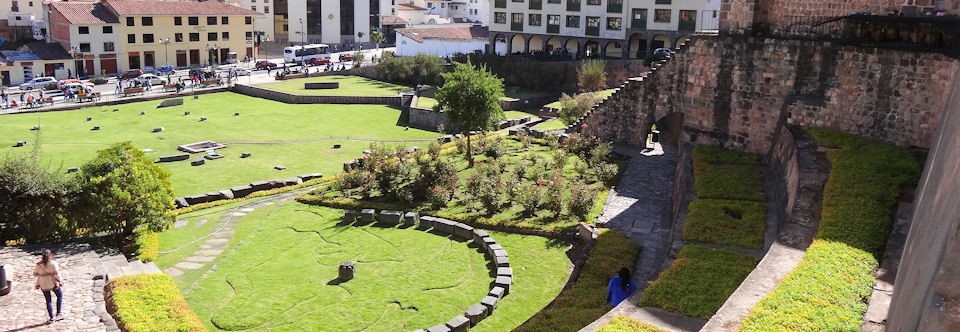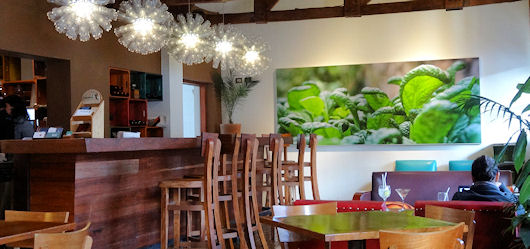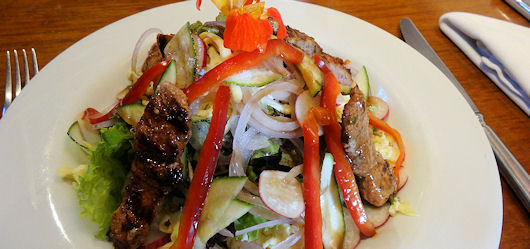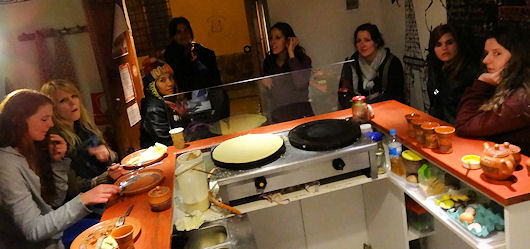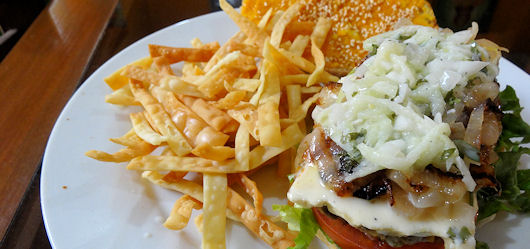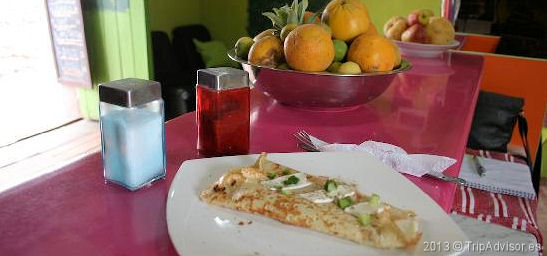‘¡Masaje, masaje, amigo!’
‘Massage, my friend.’
‘Machu Picchu tour!’
‘¡Te doy un buen precio, amigo!’
‘¿Foto señor?’
‘¿Anteojos de sol?’
‘Llévate uno, amigo. Un recuerdito.’
‘Baby alpaca, señor. 100%’
‘¡Tourist information!’
‘¡Gorras, chompas, guantes!’
‘¿Una monedita señor?’
‘¿Menú señor? Pizza a la piedra.’
Pheeep! Beebeep. Weeoo-weeoo. Beeeep.
¿Masaje?
Cusco, Peru’s tourist Mecca and economic engine of the southeast is a thriving regional centre. Launching place to the world famous Machu Picchu and Sacred Valley of the Incas, Cusco is ready to host you, feed you and sell you any number of tours and souvenirs. Hiking, biking, horse-back riding, paragliding, river rafting, arts and crafting, endless asking:
‘¿Masaje, señor?’
When you go ‘Ooooh, South America! Look Brandon, they offer return flights to Peru with accommodation in Cusco and a guided tour of the Inca trail ending at Machu Picchu. We could do that after Asia. You know? I mean, it’s $x,598 but looks really amazing!’ The Llama photoshopped into the image of Machu Picchu underneath the price tag of four digits has awakened an excitement in you to ‘discover’ South America. Well, good on you, Cusco is well worth it. I’ll leave you with my impression of the city, that is to say my impression of the touristy, old section because the majority is actually an unamazing sprawl.
An inspection of the city of Cusco reveals a city of three cultural layers – that of the Killke pre 1300 AD, followed by the Imperial Inca as part of the old kingdom of Tawantinsuyu and finally that of the Spanish conquerors. Before the arrival of the Spanish, Cusco was the centre of the entire Inca Empire, a site of great importance and enormous wealth. Divided into sections that coincided with regions of the Inca Empire, Cusco housed the leaders of said region each according to their region of governance. The central temple of Coricancha (Quechua kuri ‘gold’ kancha ‘house’) was the single most important temple in the Incan empire, dedicated to the god of ‘Inti’ the Sun. The central enclosure was constructed with Incan masonry mastery and the walls and floors were covered in gold, not gold-plating, but actual plates of gold an inch thick. The adjacent courtyard housed life-size figures of animals and humans in pure gold from the furtherest districts of the Empire. As previously explained, the temple was aligned to coincide with the solstices and movements of the sun throughout the year. The stonework survived the earthquake of 1950 experienced by Cusco in perfect condition while the colonial era contractions built over it toppled.
A history-byte seems to show that whatever the Spanish touched invariably ended in bloodshed and misery being guided by insatiable greed and a special brand of Iberian religious zealotry. Peru was a classic example of the greedy self-important technologically advanced white man meeting, killing, enslaving and exploiting brown people. This was of course after the brown people had been doing the same to themselves – the Incas were also colonisers, and rapid expansion of the Inca Empire in the decades before the arrival of the Spanish had created instabilities and resentment, with many of the colonised cultures becoming the sort of subjects of the Imperial throne that you get when you point a gun, or sharpened stake at someone’s head and demand their allegiance. Francisco Pizzaro arrived at an opportune time, when fighting had broken out between sons competing for control of the Inca empire – an empire which at the time was arguably already in decline. The victorious son Atahualpa had to contend with the conquistadores, men he didn’t understand and by whom he was greatly surpassed in technological sophistication. After some initial misgivings, Atahualpa agreed to meet Pizzaro who laid a trap for the king and his warriors. 7,000 Incas accompanied the king to the ambush when the 168 Spaniard decided to test the effect of cannons and firearms at short range against crudely armed and clueless men. Butchery ensued ending with the capture of Atahualpa, the killing of his generals and 2,000 of his soldiers. The ransom for Atahualpa was one room of gold and two of silver, which were provided by stripping the Temple of the Sun in Cusco. Afterwards Pizarro cut off Atahualpa’s head. Thus began Spanish domination in the area of modern day Peru. Conflict continued for some decades but the Spanish were ultimately victorious and free to begin wholesale widespread exploitation and colonisation.
Walking the historic section of the city is a must – by night and day. The districts immediately adjacent to the Plaza de Armas are the prettiest and most touristic of the city. To the east and northeast narrow cobbled streets wind upwards through colonial era buildings often built on the exposed stone foundations of Inca masonry. Many small cafes and eateries crowd the narrow streets or pedestrian walkways of the bohemian San Blas district, some of which are reviewed here and can be found within a short walk of each other.
Over the other side of the square is the central market of San Pedro, a typical South American market housed in a large shed/marquee. A great place to shop for just about everything from artisan products to meet, cheese, fruit, vegetables, spices and all manner of foodstuffs. Cut price eateries and juice stalls are also prominent. For the more gastronomically daring, a famous Peruvian dish of raw fish marinated in lemon juice and served with a fish broth, stir fried rice and corn can be tried. The dish is called Ceviche and is a common and popular dish throughout Peru. Having come off a rough time with food in La Paz I avoided Ceviche in Cusco, preferring to try the specialty in coastal towns where the seafood used is fresher. Ceviche belly is not uncommon amongst foreigners.
If you buy the Tourist Ticket (Boleto Turístico), spend a day touring the museums. You are given ten days in which to visit the sites featured on the ticket, many of which are right in Cusco. The museum connected with the Temple of the Sun is a let down, with poor English translations but the Regional Historical Museum is worth a visit. In a straight comparison the private museums are better because they actually have to compete and aren’t doped on government money. Not included in the ticket, but definitely worth a visit include the textile museum, a free display which is beautifully presented – connected to the weaving cooperative of Cusco’s textile showroom. Leave a tip, you’ll learn plenty. The cooperative can be found on Avenida Sol just down from the Temple of the Sun (Coricancha) on the left. The Museum of Pre-Columbian Art is another private museum, not included in tourist ticket which I found to be quite revealing. Located in Plazoleta Nazarenas just north of Calle Palacio, the museum can also be found under the name Casa de Cabrera. There is a city tour offered for about S/. 20, $8 whisks you around in a private bus with a bilingual tour guide to the important sites close or in the city of Cusco. It begins with Coricancha, the Temple of Sun in Cusco before heading out to Saqsaywaman, the large and impressive stone structure postulated to have been used for important ceremonies and which sits on the hill just behind the city of Cusco. From there to Pukapukara on the old Inca Trail, Q’enquo, the temple of the four realms of Inca cosmology: hakaq pacha (the beyond, the más allá), hanan pacha (the air, realm of the condor), kai pacha (the surface, the here and now where walketh we) and uku pacha (beneath the earth, the underworld, where sleepeth the dead). We also visited some ‘baths’ or stone fountains.
I extended my time in Cusco, abandoning plans to head north through Peru and Ecuador to the Caribbean coast of northern Colombia. Deferred, I would say, rather than abandoned, as I still hope to do it later, perhaps during the holiday time between the semester finishing in Chile and beginning in the New Year in Australia. In light of this decision, and on the advice of other travellers, I decided not to go even to Lima but remained in Cusco an extra week. There is so much to do and see in this part of the world that it seemed convenient to remain, discover more of the city and surroundings and make my way to Arequipa on my way south to Chile. I view the impending end to my travels with a twinge of sadness, not for the lack of experiences but for the mixture of wanting to continue the discoveries.
Peru is all about its history, the Inca and pre-Inca legacy extant in the stonework of ruins at sites around the country. Now for those who don’t know, I’ve been collecting the coins of each nation I have visited throughout the course my trip, seeking those in good condition to serve as souvenirs of my trip. Usually this is not a difficult task, consisting of just putting aside a nice new coin when you find it. This changed in Peru where the vast majority of the coins are horrible, aesthetically a somewhat forgettable currency. The nice coins do exist, they’re just rare so naturally when I received the change for a piece of brownie to notice a shiny new 1 sol coin it caught my interest. I noticed that on the flip side it was different to grungy coins I had in my pocket. I examined it with interest, asking someone on the street why it was different. She explained that there is a series of coins like that in circulation. Internet. Yes, there is a series, called ‘Riqueza y Orgullo del Perú’ (Wealth and Pride of Peru) featuring a series of 13 coins of 1 sol each featuring a different and famous archaeological site in Peru. Each coin is limited to a mint run of 10 million. I just had to get me one of each. They are sold as sets for like S/. 20 ($8) per 1 sol coin of the collection. Ridiculous. I was going to have to find them on the street. From then on, whenever I bought something I would ask for Nuevo Soles of the collection if they had any. With one day left in Cusco and only 4 out of 13 coins encountered I decided to offer a 3-1 reward for the coins. Most people still shook their heads at me but when walking away I was followed by someone calling after me –
‘Señor. Señor. Sí, mi madre tiene.’
For the price of 3 to 1 I found 7 more of the coins making my collection almost complete. S/. 21 for 7 coins instead of S/. 20 for each coin! How cool is it to have a collection of coins featuring that which makes Peru so special? Could you mix the hobby of coin collecting with the souvenir of a trip more perfectly? I found the last two coins in corner stores – everyone, it seems, collects them.
Restaraunt Reviews
I reached Cusco towards the end of my travels, woolly and happy and somewhat accustomed to moving around rapidly. I spent two weeks there and loved it, just loved it – and I want to go back but I think the next time it would have to be with someone because a shared experience would be the only way I could better it I think. Highly recommended to those infected with the travel bug – destination South America!


